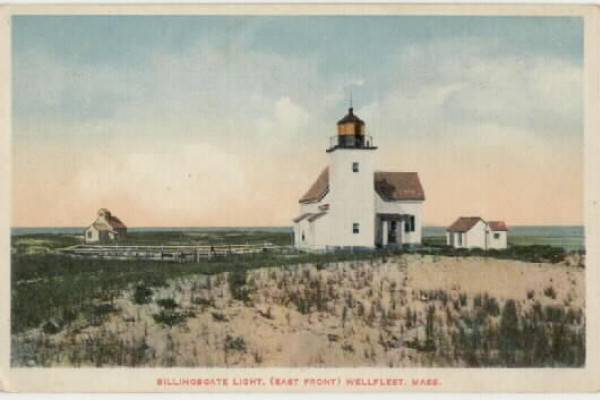
The lighthouse on what used to be Billingsgate Islands. Capecod.com photo
By Seth Rolbein
If you were to pick one English word that relates to commercial fishing with the longest history and deepest association, probably it would be “Billingsgate.”
So it’s fitting that long before the American Revolution, “Billingsgate” connected Olde England to its fish-rich colony on Cape Cod at least as much as other names like Barnstable, Chatham, and Yarmouth.
But what’s more surprising is that in modern times “Billingsgate” would also resonate in a strange nautical way and reference an even more ancient mythology and place: Atlantis.
Billingsgate’s fishy context goes all the way back to the ninth century, when trading of all kinds began to focus in a place of that name along the Thames River in London. The fish sector slowly grew and came to dominate, so much so that by 1699 the English Parliament passed an act requiring that only fish be sold at Billingsgate. By 1873 an enlarged fish hub opened on Lower Thames Street that was considered the biggest fish house in the world; 120,000 tons moved per year.
No surprise that when the Pilgrims first showed up on these shores in 1620, began exploring along the shore moving south from what is now Provincetown, and came upon a fertile waterway full of big oysters, they called it Billingsgate Bay, protected by Billingsgate Point. The fishery connection was obvious.
They didn’t spend time exploring, even less than the great French explorer Samuel de Champlain who 14 years earlier called the place “Port aux Huistres,” Oyster Harbor. They soon were off to Plymouth, but their name stuck, not his.
English settlers soon began to fan out and begin new townships; the story goes that in 1643, Governor William Bradford approached an Indian sachem he called George and asked, “Who owns Billingsgate?” George answered, “Nobody.” Bradford’s response: “Then we do.”
By the 1670s, pretty much all of the land from Yarmouth to the tip was called Eastham, but one of its northern districts remained Billingsgate, known more than anything for massive oyster beds and a near-shore whaling industry. “Blackfish” (pilot whales) abounded, and Native Americans long experienced in harpooning and driving whales ashore sometimes worked alongside the new settlers, who also built “whale houses” along the narrow spit of land that protected Billingsgate Harbor from the bay. “Trypots,” heated by wood fires, would render the valuable whale blubber; one captain from Truro recounted that in the early 1700s, he saw as many as 2000 small whales congregating in Provincetown harbor.
Billingsgate held onto its name almost until the district broke away from Eastham and established itself as an independent town, a long process that culminated in 1775 just as the country was making a much bigger split from England. There is one theory for why the historic name didn’t stick: The famous fish market had also become infamous as a place where fishmongers used the most coarse and foul language imaginable, so “Billingsgate” had come to mean vulgarity. Probably because of that, the creators of the new town figured it was better to come up with something else: Wellfleet, often spelled Wallfleet at first, was the name of a tidal creek on the east coast of England renowned for great oysters.
“Billingsgate” remained only to identify one part of the long finger of land that jutted south, dividing Cape Cod Bay from the harbor. It was on a point that included other high ground, Griffin Island and Great Island, attached like pearls at the throat of Wellfleet. But wind, wave, and erosion were scouring the strand. Small channels at high tides slowly widened, until Billingsgate no longer remained attached. It had become an island.
What we think of as remote was desirable for fishing; even as an island Billingsgate was closer to the harvest, closer to the shipping lanes. By 1822 one of the first lighthouses on Cape Cod had been built there, and soon a year-round community sprang up. By 1840 Billingsgate was home to enough children to warrant a schoolhouse serving 30-odd homes, with enough room on 50 acres for fishermen’s shacks and wharves to take advantage of a small natural harbor known as “the horseshoe.” When Thoreau made his journey to Cape Cod in 1849 he found blackfish heaped up around the lighthouse.
But Billingsgate’s highest points were no more than 10 feet above high water. By 1858 the first lighthouse had to be moved, and by 1875 the lighthouse keeper was fretting that the whole island might well wash away. He was right, but it didn’t happen overnight; into the first years of the 20th century, people still spent summers on Billingsgate, and a newer version of Billingsgate Light, 34 feet tall, still beamed into the bay, a beacon for mariners.
In 1910 the federal government decided to build a granite breakwater to try to protect the light. But the badly designed jetty hastened scouring behind it, becoming a last straw. An automated beacon replaced the lighthouse, the last keeper with his family moved to Gloucester Harbor, and the brick structure tumbled to its knees into the bay in 1918.
Billingsgate vanished. For years after, at low tides, people might drop anchor at a sandbar on the site and do some clamming, or rummage for old brick remnants of the lighthouse. But even these remains have slowly diminished as storms and tides smooth down whatever might resist them.
So that is why Billingsgate, already steeped in fishing lore, took on yet one more association: Our small version of Atlantis.
